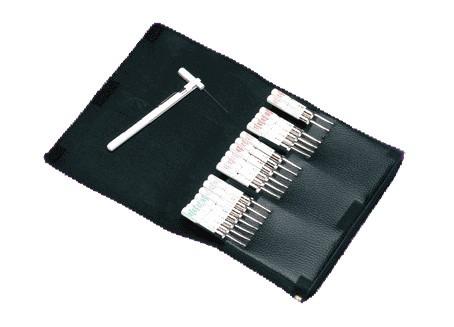Touch Test Sensory Kit Cutaneous Sensitivity in Clinical Ranges w/
The Touch Test Sensory Evaluator Kit is used for diagnosing pathologies of crude touch sensation in humans or animals. Rats may be used because of the paw withdrawal reflex. The kit follows the Von Frey concept, which is based on the principle that a hair pressed against the skin with increasing proximity will increase in force applied until it bends, and no more. After that, the force is fairly constant or declines.
This physical fact is used to make a stimulator that can be hand applied, yet delivers a consistent and reproducible force. The force applied is a property of the hair thickness and material composition. The kit includes 20 hairs of graded sizes, with known cliinical significance.
Learn more
May be Used on Animals or Humans
Long standing clinical use and FDA registration
Paw Withdrawal Reflex Reveals Animal Response
Animals signal detection of the probe touching plantar surface by prompt paw withdrawl.
Kit of 20 Probes
Logarithmic series of probe intensities show linear detection responses.
Testimonials
"Bronson Methodist Hospital: a systematic approach to validating xylene‑free processing"

Leica PELORIS improving workflow, safety, and productivity

Excellent results with Leica PELORIS xylene-free processing

Going green with a next generation tissue processor

Publications
The following publications cite the Leica Biosystems product for Research Use Only.
Genome-Wide Screen Identifies Drug-Induced Regulation of the Gene Giant Axonal Neuropathy (Gan) in a Mouse Model of Antiretroviral-Induced Painful Peripheral Neuropathy. Susan G. Dorsey, Carmen C. Leitch, Cynthia L. Renn, Sherrie Lessans, Barbara A. Smith, Xiao M. Wang, Raymond A. Dionne. Online before print April 26, 2009, doi: 10.1177/1099800409332726 Biol Res Nurs July 2009 vol. 11 no. 17-16.
Brain-derived neurotrophic factor modulates antiretroviral-induced mechanical allodynia in the mouse. Cynthia L. Renn, Carmen C. Leitch, Sherrie Lessans, Peter Rhee, W. Cameron McGuire, Barbara A. Smith, Richard J. Traub, Susan G. Dorsey. Journal of Neuroscience Research Volume 89, Issue 10, pages 1551–1565, October 2011 6 JUN 2011 DOI: 10.1002/jnr.22685
Multimodal assessment of painful peripheral neuropathy induced by chronic oxaliplatin-based chemotherapy in mice. Cynthia L Renn, Valentina A Carozzi, Peter Rhee, Danisha Gallop, Susan G Dorsey and Guido Cavaletti. Molecular Pain 2011, 7:29 doi:10.1186/1744-8069-7-29.
Cyclooxygenase-1 in the spinal cord plays an important role in postoperative pain. Zhu X, Conklin D, Eisenach JC.. Pain. 2003 Jul;104(1-2):15-23
Rehabilitation of the Hand: Surgery and Therapy edited by James M. Hunter, Lawrence H. Schneider, Evelyn J. Mackin, and Anne D. Callahan, 3rd ed, 1258 pp, ISBN 0-8016-2472-X, St Louis, Mo, CV Mosby Co, 1990
The repeatability of testing with Semmes-Weinstein Monofilaments
Judith Bell-Krotoski, Elizabeth Tomancik. The repeatability of testing with Semmes-Weinstein Monofilaments. The Journal of Hand Surgery 12A: 155-161, 1987
Genome-Wide Screen Identifies Drug-Induced Regulation of the Gene Giant Axonal Neuropathy (Gan) in a Mouse Model of Antiretroviral-Induced Painful Peripheral Neuropathy.
Susan G. Dorsey. Biological Research For Nursing, Vol. 11, No. 1, 7-16 (2009)
In vivo evidence that truncated trkB.T1 participates in nociception.
Cynthia L Renn, Carmen C Leitch and Susan G Dorsey. Molecular Pain 2009, 5:61
